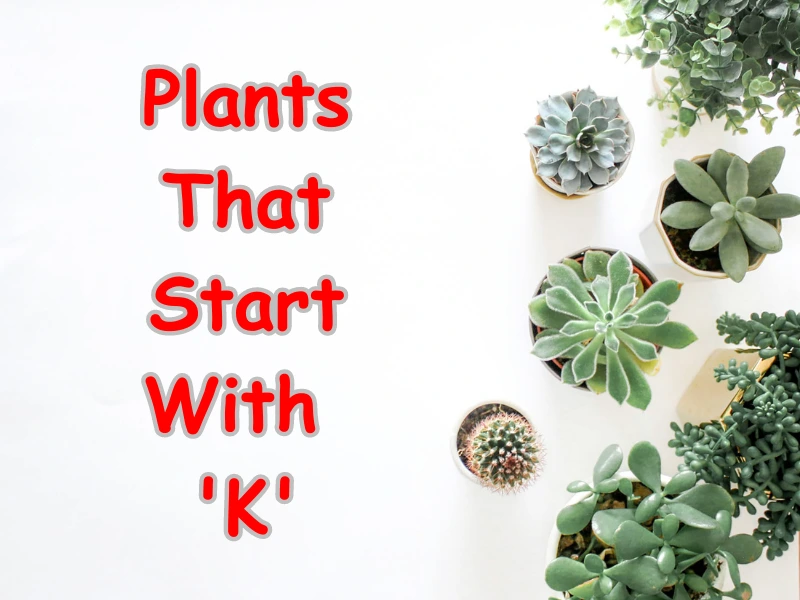
Intriduction
If you’re an enthusiastic gardener or a plant lover looking to expand your green collection, exploring different plants can be an exciting and rewarding journey. In this beginner’s guide, we will take you through a diverse list of plants starting with the letter “K.” From vibrant flowers to lush foliage, you’ll discover a range of options that can thrive in various environments, whether you have a garden, a windowsill, or an indoor space.
Kalanchoe (Kalanchoe blossfeldiana):
Kalanchoe is a popular succulent that’s known for its vibrant, long-lasting flowers. It comes in various colors like red, pink, yellow, and orange. Kalanchoe is a low-maintenance plant, making it an excellent choice for beginners or those with a busy schedule.
Kangaroo Paw (Anigozanthos):
This striking plant hails from Australia and features unique flowers that resemble a kangaroo’s paw, hence the name. Kangaroo Paw comes in a range of colors, including red, orange, yellow, and green. It thrives in well-draining soil and prefers a sunny spot in the garden.
Kentia Palm (Howea forsteriana):
The Kentia Palm is a beautiful indoor plant that adds a touch of elegance to any space. It has graceful, feathery fronds and is well-suited for homes or offices with low light conditions.
Kaffir Lily (Clivia miniata):
Also known as the Natal lily, the Kaffir Lily boasts stunning clusters of trumpet-shaped flowers in shades of orange, red, or yellow. It’s a hardy plant that can tolerate low light and is ideal for brightening up indoor spaces.
Kiwi (Actinidia deliciosa):
While you might be familiar with the delicious fruit, the Kiwi plant is an attractive climber that can adorn walls, trellises, or fences in your garden. It requires a sunny location with well-draining soil.
Knock Out Rose (Rosa ‘Knock Out’):
If you’re looking for a low-maintenance rose variety, the Knock Out Rose is a top contender. It blooms profusely throughout the growing season and is disease-resistant, making it perfect for gardeners of all skill levels.
King Protea (Protea cynaroides):
The King Protea is a spectacular flowering plant native to South Africa. Its large, showy flowers with pink-tipped petals make it a striking addition to any garden or floral arrangement.
Kale (Brassica oleracea var. sabellica):
For gardeners interested in growing edible plants, Kale is an excellent choice. This nutritious leafy green is packed with vitamins and minerals and can withstand cooler temperatures, making it suitable for fall and winter gardening.
Katsura Tree (Cercidiphyllum japonicum):
The Katsura Tree is a deciduous tree known for its heart-shaped leaves that turn beautiful shades of yellow, orange, and red in the fall. It prefers a sunny to partially shaded location and well-draining soil.
Kapok Tree (Ceiba pentandra):
The Kapok Tree is a massive tropical tree known for its fluffy seed pods and towering height. While it’s not suitable for small spaces, it’s a fascinating plant for those with ample outdoor room and a warm climate.
Kwanzan Cherry (Prunus serrulata ‘Kwanzan’):
The Kwanzan Cherry is a stunning ornamental cherry tree that bursts into a profusion of double-pink blossoms in the spring. It’s a popular choice for adding a touch of elegance to landscapes and gardens.
Kidney Bean (Phaseolus vulgaris):
If you’re interested in growing vegetables, Kidney Beans are a great option. These beans are not only nutritious but also add nitrogen to the soil, benefiting other plants in the vicinity.
Whether you’re an experienced gardener or a novice, these plants starting with the letter “K” offer a diverse range of options to suit different tastes and gardening environments. Remember to provide adequate care, including proper watering, sunlight, and soil conditions, to ensure these plants thrive and flourish.
Conclusion:
In this beginner’s guide, we’ve explored an exciting assortment of plants starting with the letter “K.” From vibrant flowers like the Kalanchoe and King Protea to lush foliage plants like the Kentia Palm and Kale, there’s something for every plant enthusiast. Whether you have a garden, a small balcony, or an indoor space, these plants can add beauty, color, and a touch of nature to your surroundings. Remember to research each plant’s specific care requirements and enjoy the journey of nurturing these green companions.
FAQs:
- Q: Can I grow Kalanchoe outdoors? A: While Kalanchoe is often grown as an indoor plant, it can be cultivated outdoors in warm climates with well-draining soil.
- Q: How often should I water the Kangaroo Paw plant? A: Kangaroo Paw prefers well-drained soil and should be watered moderately, allowing the soil to dry slightly between waterings.
- Q: Is the Kentia Palm suitable for beginners? A: Yes, the Kentia Palm is an excellent choice for beginners as it can tolerate low light and requires minimal maintenance.
- Q: Are Kiwi plants self-pollinating? A: Most Kiwi varieties require both male and female plants for pollination and fruit production.
- Q: Can I grow Knock Out Roses in containers? A: Yes, Knock Out Roses can thrive in containers, provided they have good drainage and receive sufficient sunlight.
- Q: How tall does the Katsura Tree typically grow? A: The Katsura Tree can grow up to 40-60 feet tall in optimal conditions.
- Q: Can I eat the beans from a Kidney Bean plant? A: Yes, Kidney Beans are edible and are commonly used in various cuisines.
- Q: Is the Kapok Tree suitable for urban environments? A: Due to its large size, the Kapok Tree is more suitable for rural or spacious suburban areas than urban environments.

